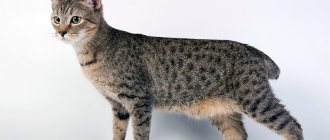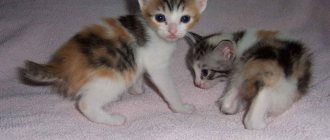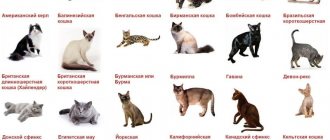Description of the Burmilla breed
Popularity 53rd place among 87 cat breeds
Lifespan:
18-19 years old
Height:
25-30 cm
Country of origin:
Great Britain
Average price:
35-40 thousand rubles
Weight:
4-7 kg
Latest articles Cat health
Ataxia in cats: what is it, how does it manifest and is treated 01/23/2022 163 0 0
Cat health
Leukemia, or viral leukemia in cats 01/23/2022 148 0 0
Key facts
The official name of the breed is Burmilla. Because of its color, the cat is often called the Burmese silver.
According to the approved breed description, the Burmilla has a soft chinchilla-like coat. The most popular are those with short fur and low maintenance requirements. The cost of keeping long-haired cats is higher, but they are gradually winning the hearts of cat lovers with their spectacular appearance.
Key characteristics of the Burmilla breed include an easy-going nature. She is tactful and not pushy. Such pets are kind to children - in joint games they will protect the child from danger and will never bite him in response to a prank. Representatives of this breed are people-oriented. They are happy to keep company even with strangers.
The life expectancy of a Burmilla is 18-19 years. How long a cat lives depends on hereditary predisposition to diseases.
Hereditary diseases
In the description of the Burmilla cat breed, one can highlight their good health. This is not a pet that will sneeze at the slightest draft. However, there are still some problems.
Polycystic kidney disease
Burmillas are predisposed to polycystic kidney disease, which causes kidney failure. To minimize risks, it is necessary to conduct a preliminary examination of the breeding couple. If the cat and cat are healthy, then the kittens will be healthy, and nothing will threaten the next generations. It is recommended that cats aged 5 years and older undergo annual examinations to avoid wasting time if the disease is present.
Tendency to allergies
An increased tendency to allergies can cause problems with food selection. Many components are perceived negatively by animals. It is necessary to choose premium food and consult a veterinarian.
Descriptions of allergy manifestations vary. Most often this is redness and itching behind the ears, as well as areas of hair loss and itching on the stomach, on the inside of the paws.
History of the origin of the Burmilla
The country of origin of the breed is considered to be Great Britain, where in 1981 there was an accidental mating of two cats of different breeds. The owner of the unusual offspring was Baroness Miranda von Kirchberg, a famous breeder of Burmese and Persian cats. Due to the negligence of a servant, one of the Burmese was freed and met with a Persian. As a result of their short-term union, the Burmilla appeared.
Kirchberg was amazed by the gentle disposition and silvery hair of the newborns. She rushed to tell her friend Teresa Clark about the newborns. Having united, the women showed their discovery to geneticist Roy Robinson. The unusual kittens interested the scientist, who saw a bright future for them.
3 years later, in 1984, another offspring with greater variation in colors received the first standard from the felinological organization GCCF. In the same year, thanks to Clarke’s efforts, the first club of fans of the new breed appeared.
Soon, some of the Burmilla kittens came to Denmark, causing great delight on the part of local breeders. From that moment on, the Scandinavian line began its development. Despite its growing popularity, international organizations were in no hurry to approve the breed. The CFA recognized it only in 2014. At the same time, breeding began in Russia.
The name of the breed was obtained by merging the names of the breeds of its progenitors. The combination of a Burmese and Persian cat did not give a euphonious name, so the name of his chinchilla color was borrowed from his furry father.
What does a Burmilla look like?
In the photo of the Burmilla you can see one of its key features - its eyes, outlined with black edging. They look as if someone deliberately tinted them with eyeliner to make them even more expressive.
Representatives of this breed have weak sexual dimorphism. The sizes of girls are not much inferior to boys. On average, animals weigh 4-8 kg, and their height at the withers is 25-30 cm.
Muzzle
The breed is characterized by a medium-sized head with a blunt wedge shape. The short, rounded muzzle has plump cheeks. In males they are always larger. The width of the skull gradually tapers off from the forehead to the chin.
The contour of the muzzle is harmoniously continued by widely set ears. They are slightly inclined forward and rounded at the tips. When examining the profile, a clear stop is noticeable. The cat's nose, like its eyes, is framed with a black outline.
Expressive large eyes are no less widely set. The curved line of the upper eyelid gives it a similarity to oriental breeds, but the lower eyelid is curved into a smooth crescent. Amber and green iris colors are allowed. Kittens have a more reddish hue. It approaches the standard soon after maturity.
Body type
The cat's body is compact and muscular. Despite her strong bones, she looks very elegant and even a little fragile, but this impression is wrong. The wide chest is well defined, and a small hump of wool is clearly visible at the withers. The length of the shoulders and hips is the same.
The hind limbs are longer than the forelimbs. Their muscles are well developed. The rounded paws are equipped with black pads. The movable tail is of medium length and gradually tapers to a rounded tip.
Coat and color
The standard allows two varieties of Burmilla: smooth-haired and long-haired. Both species have soft, smooth and silky fur. Its hairs are colored zonally, that is, the color of the undercoat and the awn are different.
The color of the Burmilla can be shaded, solid, smoky or brindle. The color of the hairs on the back is always darker than on the belly. The undercoat is colored silver or gold, and the guard hair has many more options:
- chocolate;
- cream;
- lilac;
- brown;
- blue (gray).
Due to the different pigmentation of the hairs, the coat has a characteristic shine. Cats inherited this feature from the chinchilla Persian.
Animal appearance
Externally, representatives of the breed look like this:
- Color. Can be white-silver or silver-shaded, the undercoat is golden or silver.
- Ears. Set wide apart, with a slight lean forward.
- Body. Compact, medium in size, hips and shoulders are the same width. Rounded wide chest, croup slightly higher than shoulders.
- Tail. The length is medium, pointed and turns into a rounded tip.
Those who saw what a Burmilla looks like, a photo of which is freely available on the Internet, could not help but notice the effect of a translucent cape that is created when looking at the wool. The neck in the lower part, belly and chest of the animal are always painted white, the muzzle, paws and tail are white-silver. One of the following shades may be visible on the head, back, and sides:
- Caramel.
- Red.
- Brown.
- Lilac.
- Blue.
- Chocolate.
- Cream.
Burmilla character
The sociable nature of the Burmilla and its “talkativeness” help to find quick contact with humans and other pets. Despite the fact that the cat loves to sit in the arms, she never imposes herself and chooses a time convenient for the owner.
If people pay attention to her, then the pet happily demonstrates her violent flow of emotions. She is not afraid of strangers and confidently greets them at the door.
The cat often suppresses its activity so as not to cause trouble to its owners. If you or your child takes the initiative on your own, she will happily support it. When playing with children, the chinchilla pet is very reserved and careful. Only she herself can suffer, since an attack on her little owner is taboo for her.
The cat's friendliness even extends to dogs. When communicating with other four-legged animals, she tries to show her superiority, she may become jealous, but she will never show open aggression.
Due to its intolerant attitude towards loneliness, the breed is suitable for those who have a lot of free time. You should not get this cat if you are a workaholic and rarely appear at home. Lack of attention has a detrimental effect on her psyche, so it is better to choose a different breed.
These animals have high intelligence. They quickly figure out how to open the kitchen cabinet and get to the food. The only downside is that a developed mind is combined with curiosity. On a walk, a pet can easily get lost if it gets carried away by something interesting.
Colors
Burmilla have a lot of colors, but they are all similar to each other. It seems that the gray cat was wearing a cape slightly darker than its color. So, a variety of capes:
- tortoiseshell;
- Bombay;
- cream;
- chocolate;
- smoky;
- lilac;
- brown;
- brindle:
- speckled black;
- mottled blue.
Thus, we can say that Burmillas have a fairly large range of colors. However, all these colors have a chinchilla tint.
Raising a Burmilla
The basics of parenting are laid down by the mother, so it is very important not to take the baby away too early. She shows her kittens how to properly groom themselves, which makes training much easier in the future. Animals adopted through the nursery are already accustomed to the tray and scratching post, so they very quickly find their way around a new place.
Training a Burmilla cat is based on mutual respect. Do not try to put pressure on your pet or try to threaten it. A good result is achieved only when the animal performs actions of its own free will.
To wean yourself from unwanted actions, use auxiliary tools: newspaper, spray bottle and your voice. If your pet persistently chews and scratches everything that moves, gently hit him with a rolled-up newspaper, spray him with water, or simply demonstrate your indignation. Do not shout or hit the animal, so as not to cause the opposite effect. An offended or frightened cat may begin to go to the toilet past the litter tray out of revenge or fear.
Trained pets can learn simple tricks. They quickly remember their nickname and are happy to bring toys. These simple commands evoke pleasant associations, since the animal receives affection and approval from the owner for its efforts.
Burmilla health
With proper care, Burmilla health problems occur very rarely. Most of their diseases are hereditary, so when choosing a kitten, be sure to read the information about the parents.
To build a strong immune system, make sure you have enough vitamins. Typically, mineral and vitamin complexes are prescribed by a veterinarian, based on the tests of a mustachioed patient. They will have to be taken annually, since less frequent visits are fraught with late detection of hidden pathologies.
It is also important to remember about vaccinations. A vaccine is the only effective way to protect against viral infections. They promote the formation of an immune response and prevent infection.
Possible diseases
Artificially bred breeds are more vulnerable than native ones. The poor Burmillas inherited Persian polycystic kidney disease. Its appearance can be recognized by the following symptoms:
- frequent trips to the toilet;
- loss of appetite;
- sudden weight loss;
- lethargy and lethargy.
If such symptoms appear, consult a doctor immediately. Numerous cysts on the kidneys impair the functionality of the organ and can lead to kidney failure.
Another possible pathology is congenital keratoconjunctivitis, that is, inflammation of the cornea and conjunctiva. Due to the desiccation of the stratum corneum, the patient often develops vascularization, when blood vessels grow into the corneal tissue.
Males may develop orofacial pain syndrome. This disease has been little studied, so its exact cause is still unknown. Symptoms of the pathology include intense lip licking and constant chewing movements.
Animals are also vulnerable to allergies. To avoid an allergic reaction, never smoke around your pet and hide household chemicals in inaccessible places. If you experience a runny nose, watery eyes, red eyes, itching or rash, consult your doctor. The patient's condition is normalized with the help of individually selected antihistamines.
Reproductive health
The small number of representatives greatly complicates breeding. You can wait years for a purebred mating partner. If you cheat and try to act by analogy with the founder of the breed, then animals that meet the standard will appear only in the sixth generation. Because of this, matings between Burmese and chinchillas are practically not carried out.
The birth of offspring is planned no earlier than the third heat. Pregnancy lasts about 9 weeks, and the moment of birth is calculated individually. To get healthy kittens, it is important to carefully study the pedigree of your partner and examine your own pet.
Pet class animals are not allowed for breeding. Such pets undergo castration or sterilization, which eliminates reproductive function. Surgery may also be required for more elite representatives if their owner does not intend to raise kittens.
Diseases
Burmilla, despite its external fragility, has fairly good health. However, any interference with nature reduces natural immunity. That is why purebred cats have much more specific diseases than ordinary “Barsiks” and “Muroks”.
But even if the cat lives inside the house and doesn’t go outside for walks, it still needs vaccinations! The owner can carry germs on his own clothes or shoes, and then his pet will have a hard time. Before each vaccination it is necessary to drive away worms!
According to veterinarians, there are no characteristic diseases in Burmillas, but sometimes a pathology such as polycystic kidney disease is transmitted in the hereditary “baggage”.
With this disease, multiple cysts grow in the kidneys of cats. They fill with fluid, gradually affecting both kidneys and causing gradual intoxication of the body. Treatment cannot be delayed, since the disease, although it does not cause immediate death, is extremely painful. A complete cure is impossible, but it is quite possible to stop development and give the animal a few more years of life.
Expert opinion
Dusheba Vera Ivanovna
In 2010, she graduated from the Moscow State Academy of Veterinary Medicine named after K.I. Scriabin with honors, specializing in veterinary medicine. I regularly attend veterinary conferences, congresses, and webinars.
If you are planning breeding, remember: “mating” Burmilla with individuals of other breeds leads to the loss of dominant characteristics. Suitable age for mating: 14-16 months. It is not recommended to breed cats younger than this age: since the bones of the “young animals” are not strong enough, the cat will develop a deflection of the spine (from a heavy belly), and the birth itself will be difficult. If you don’t need offspring, don’t be lazy and take your pet for castration (sterilization). In Burmillas, unlike many other breeds, sexual activity lasts throughout the year; a spree can begin at any time. Think: is it worth torturing both the animal and yourself? The operation is permitted from 1.5 years.
Features of feeding and diet
Balance in the diet is important. Too few nutrients can lead to health problems, and too much food can lead to obesity. An adult pet is fed twice a day, giving no more than 150-200 g at a time. Up to 1 year, frequency and portions depend on age:
- newborns - mother's milk on demand;
- from 2 to 3 months – 5-6 times a day, but not more than 120-160 g per day;
- from 3 to 4 months – 4 times a day, 200-240 g per day;
- from 4 months to one year – 3 times a day, 250 g per day.
Try to feed in a certain place and do not give in to nighttime provocations. This will help wean the animal from begging and serenading you while you sleep. Also, adherence to the regime has a beneficial effect on the digestive tract.
When eating natural foods, use lean meat and poultry. Serve them along with cereals and vegetables. For a shiny coat and smooth bowel function, include fermented milk products in your menu.
Suitable vegetables include beets, zucchini, carrots and pumpkin. You will have to avoid tomatoes and eggplants, as they often cause diarrhea. Grapes and raisins are also prohibited. They can lead to acute poisoning.
For simplicity, you can use ready-made food. All norms are indicated on the packaging, which makes it easier to calculate portions based on the age and weight of the pet. Opt for quality products. Economy class food has low energy value and questionable ingredients. Not only will they not satiate the cat, but they can also provoke a number of diseases in him.
Care and maintenance
Care and maintenance of the Burmilla differs slightly depending on the length of its coat. For short-haired dogs, it is enough to brush them once a week, while for long-haired dogs you will have to spend 3 times more time. Also, the frequency of brushing will have to be increased during shedding. This is necessary to prevent tangles.
In addition to grooming, don't forget about:
- Nail trimming. This procedure will not be necessary only for those who have free access to the street.
- Cleaning the ears, eyes and mouth. The cat should be cleaned daily to remove eye discharge that accumulates after sleep. The ears are quite small, so they accumulate dust and dirt for a long time. To keep them clean and healthy, monthly treatment with a special lotion, vegetable oil or plain water is sufficient. Like your ears, you will have to brush your teeth once a month. This will prevent the formation of plaque and caries.
- The washing up. Bathing is carried out only when dirty. Pets living at home are washed less often. To maintain the quality of the coat, veterinary shampoos designed for short-haired or long-haired cats are used.
Accustom your animal to grooming from childhood. Cats really do not like any procedures that limit their freedom. If you have never bathed your pet during the first two years of its life, then you can rest assured that the procedure will end in psychological trauma for the cat and physical trauma for you.
Coat color
The Burmilla is a cat that always has a shaded color on its coat. The background color is always a light silver shade. The splashes of color only slightly affect the light coat. There are also different patterns - tabby, point, etc. You can see the color features in the photo below.
Lilac
The color is a light shade with a small splash of purple. The color can be seen in the photo. One of the most popular colors.
Chocolate
Burmilla comes in a variety of colors. Many of them are practically encountered. This is due to the complexity of selection and transportation of pets. Cost-effective colors are imported into the CIS countries. For this reason, it is difficult to find chocolate-colored Burmilla. They are distinguished by their milky brown coat, amber eyes and darker muzzle.
Black
A pure black Burmilla is extremely rare in a litter. Finding such a kitten is not so easy.
Cream
The Burmilla, descended from the chinchilla, always has shaded or tipped colors. Small splashes of cream and peach color create a “warm” shade of the coat.
Point color
A short-haired cat looks especially impressive with a point color.
Tabby
Tabby is a striped color. Rarely seen. The stripes on the coat are not as clear as on the British tabby color. Often the tabby coloring affects only the lower part of the paws and the mask on the face, rarely covering the entire body.
Golden
This color is recognized only by the Czech Breeders Association.
Interesting!
The Burmilla, as a long-haired cat, is not recognized by phenological organizations. Although long-haired kittens often appear in litters.
Tips for choosing a kitten
It is better to buy Burmilla kittens only from licensed establishments. If you don’t know how to choose a purebred animal and not run into a mestizo, then stick to this option and don’t try to save money.
Nursery employees often provide free consultations to future owners, showing documents for kittens and their parents. After meeting the kids, you can easily make a choice, since their health is confirmed by the presence of a veterinary passport. The presence of sick animals is permissible only if they are isolated in a separate room and are not put up for sale.











